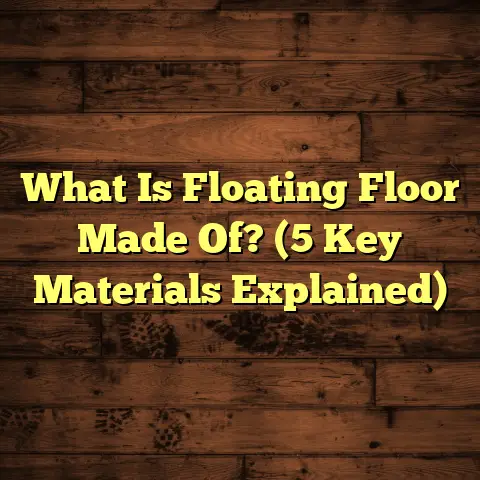What is Sealing Basement Floors? (5 Benefits for Moisture Control)
Sealing basement floors is something many homeowners tend to overlook until they start noticing problems. But trust me, when moisture creeps into your basement, it’s a ticking time bomb. You wake up one day to a musty smell lingering in the air, or maybe you spot water stains crawling along the walls. You might even see mold patches showing up in corners you thought were dry. That’s the kind of situation that demands urgent attention. Moisture in basements doesn’t just cause minor annoyances—it can rapidly turn into a costly nightmare, threatening your home’s structure and your family’s health.
I’ve seen this firsthand in my years working as a flooring contractor. Basements are particularly vulnerable because they’re below ground level, where humidity and water pressure from the soil can easily push moisture through the concrete slab. If you don’t act quickly to control this moisture, serious damage can follow. To protect your home, one of the best steps you can take is sealing your basement floor.
What is Sealing Basement Floors?
So, what exactly is sealing basement floors? Let me break it down for you.
At its core, sealing a basement floor means applying a protective coating or treatment to the concrete slab that prevents water and moisture from penetrating through it. Concrete is naturally porous, almost like a sponge. This means it absorbs water from the ground beneath it or from humid air in the basement. Over time, this moisture can seep up through cracks and pores in the concrete, causing dampness on the surface.
When you seal the floor, you create a barrier that stops this moisture from coming up and damaging your basement environment. This barrier can be formed by different materials—some sealants soak into the concrete to block its pores (penetrating sealers), while others create a tough surface layer on top (film-forming sealers). Common materials used include epoxy coatings, polyurethane sealers, acrylics, and silane/siloxane products.
The main goal is to reduce or eliminate water vapor transmission through the slab. This keeps your basement dry and comfortable, preventing many moisture-related problems before they start.
Why Basement Moisture is a Bigger Problem Than You Think
You might be wondering why sealing basement floors to control moisture is such a big deal. After all, basements are underground—they’re supposed to be a little damp, right?
Not quite.
Basement moisture isn’t just an inconvenience; it’s one of the leading causes of home damage and health issues related to indoor air quality.
The Extent of Basement Moisture Problems
Statistics show that nearly 50% of all homes experience some form of basement moisture problem during their lifetime. In some regions with high water tables or heavy rainfall, this number is even higher.
Here’s the thing: moisture problems rarely stay confined to the basement itself. They spread. Moisture moving up through the floor can cause wood rot in floor joists above, damage drywall and paint finishes in adjacent rooms, and create ideal conditions for mold growth.
Mold is particularly worrying—it releases spores that can trigger allergies, asthma attacks, and other respiratory issues. According to the Environmental Protection Agency (EPA), damp or wet basements increase the risk of mold growth by up to 60%, which can have serious health implications if left untreated.
The Real Cost of Moisture Damage
Ignoring basement moisture can cost you thousands in repairs down the road. Structural damage caused by persistent dampness weakens concrete and wood framing over time. Mold remediation alone can run from $500 to $6,000 depending on severity.
That’s why I always tell my clients: Don’t wait for visible signs of damage before taking action. Sealing your basement floor is a proactive way to stop moisture problems at their source.
Five Benefits I’ve Seen from Sealing Basement Floors
Let me share five solid benefits I’ve witnessed over and over when sealing basement floors for moisture control. These benefits are backed by research but also come from real-world experience working inside hundreds of homes.
1. Stops Water From Seeping Up Through Concrete
Concrete’s porosity means water vapor can easily move through it unless you do something about it. When you apply a quality sealant designed for moisture control, it dramatically reduces water vapor transmission through the slab.
A study conducted by the National Concrete Masonry Association found that sealing can reduce water vapor transmission by up to 90%. This means almost all moisture trying to push up through cracks or microscopic pores in your concrete gets stopped cold.
This benefit is especially critical if your basement is below the water table or located in an area with heavy seasonal rainfall or snowmelt. I had one client living near a lake where groundwater levels fluctuate seasonally. After sealing their basement floor with a penetrating silane-siloxane sealer, their basement humidity dropped from 75% down to 45% within a few weeks—a huge difference in comfort and moisture control.
2. Prevents Mold and Mildew Growth
Moisture is mold’s best friend—it provides the perfect environment for spores to settle and multiply. Once mold takes hold on concrete or organic surfaces nearby like wood or drywall, it spreads fast.
By sealing your basement floor, you cut off one of mold’s primary moisture sources—water vapor coming through concrete.
Research shows that sealed floors reduce mold risk by more than half compared to unsealed ones because they keep surfaces drier and less hospitable to fungal growth.
I remember a family who kept battling black mold patches in their finished basement despite cleaning regularly. Once we sealed their floor and added some ventilation improvements, those mold spots disappeared completely—and haven’t come back since.
3. Protects Flooring Materials You Install on Top
If you want to use your basement for more than storage (think living space or workshop), chances are you’ll install flooring like carpet, laminate, hardwood, or vinyl over the concrete slab.
Moisture coming up through the slab can ruin these floors fast:
- Wood planks warp or cup.
- Vinyl tiles lose adhesion.
- Carpets smell musty and develop mildew underneath.
Sealing creates a reliable moisture barrier that preserves these investments and extends their lifespan.
One client spent over $8,000 on hardwood flooring for their basement only to see boards warp within months due to trapped moisture. After sealing their slab properly and replacing damaged boards with engineered wood designed for basements, they finally had stable flooring that lasted years without problems.
4. Improves Energy Efficiency
You might not realize how much moisture affects your heating and cooling costs until you control it.
Moist air holds heat differently than dry air—it causes your HVAC system to work harder to maintain comfortable temperatures. In fact, research from the U.S. Department of Energy estimates that reducing indoor relative humidity by just 10% can improve heating efficiency by around 5%.
Sealed basement floors keep humidity levels down by stopping water vapor intrusion at its source—meaning your furnace or air conditioner doesn’t have to fight excess moisture all winter or summer long.
Some clients have reported lowering their energy bills by 8-10% after tackling basement moisture with floor sealing combined with other fixes like gutter maintenance and sump pumps.
5. Enhances Indoor Air Quality
Basements often act like a “trap” for poor air quality because they’re enclosed spaces with limited airflow and lots of moisture sources.
Dust mites thrive in humid conditions, and mold spores float freely in damp air—both common allergy triggers.
By sealing your basement floor and controlling moisture buildup, you improve overall air quality throughout your home because fewer allergens circulate upstairs too.
One client with severe seasonal allergies told me their symptoms improved significantly after we sealed their basement floor as part of a larger indoor air quality improvement project—no more sneezing fits during winter months!
How I Approach Sealing Basement Floors: My Step-by-Step Process
Sealing your basement floor isn’t just about picking a product off the shelf and slapping it on randomly. From my experience working with both DIYers and professional contractors, success comes down to preparation, product choice, and proper application.
Here’s exactly how I tackle it:
Step 1: Thorough Inspection and Assessment
Before any sealing happens, I inspect the entire basement thoroughly:
- Look for cracks or gaps in concrete floors or walls.
- Check for signs of active water intrusion like efflorescence (white salt deposits).
- Test humidity levels using a hygrometer.
- Assess drainage around the house exterior.
- Identify any plumbing leaks contributing to dampness.
Sometimes sealing alone isn’t enough if there are major foundation cracks or drainage issues. Fixing those first saves time and money long-term.
Step 2: Repair Cracks and Prepare Surface
If cracks exist in your slab, they need filling with appropriate epoxy or polyurethane crack fillers before sealing. Uneven or rough surfaces usually require grinding or patching for smooth application.
Cleaning is critical here—I use heavy-duty degreasers and sometimes even acid etching to remove dirt, oil stains, or old coatings that could prevent good adhesion.
The floor must be completely dry before applying any sealant—moisture trapped under coating will cause peeling or bubbling later on.
Step 3: Selecting the Right Sealant
There are many sealant types on the market; choosing one depends on your goals:
- Penetrating Sealers (silane-siloxane): These soak deep into concrete pores and block water vapor but leave breathable surfaces.
- Epoxy Coatings: Durable film-forming sealers providing thick waterproof layers but require professional application.
- Acrylic Sealers: Easy to apply but wear faster; best for light-duty protection.
- Polyurethane Sealers: Tough coatings good for areas with heavy foot traffic or machinery.
For most homeowner basements focused on moisture control without heavy traffic concerns, I recommend high-quality penetrating sealers that last years and don’t trap moisture inside concrete.
Step 4: Proper Application Techniques
Applying sealant evenly is crucial:
- Use rollers or sprayers designed for sealants.
- Apply multiple thin coats rather than one thick coat.
- Follow manufacturer’s instructions regarding drying times between coats.
- Ensure good ventilation during application to avoid fumes buildup.
I usually spend at least two days on this step—one day prepping and cleaning, then another applying coats for best results.
Step 5: Final Recommendations After Sealing
Sealing isn’t an end-all solution alone; I advise clients on additional steps:
- Install dehumidifiers to keep relative humidity below 60%.
- Ensure gutters direct rainwater away from foundation.
- Maintain sump pumps if installed.
- Consider adding insulation or vapor barriers on walls for full protection.
Case Study: Turning Around a Damp Basement Nightmare
Let me tell you about one project where sealing made a huge impact:
A couple purchased an older house built in the 1950s with an unfinished basement smelling strongly of mildew year-round. The concrete floor was cracked and wet near one corner where groundwater pooled after rains.
After inspecting, we found foundation cracks contributing to water infiltration alongside high humidity due to poor ventilation.
Here’s what we did:
- Repaired foundation cracks with epoxy injection.
- Installed exterior drainage improvements.
- Cleaned and prepped basement floor thoroughly.
- Applied two coats of penetrating silane-siloxane sealer.
- Added a high-capacity dehumidifier running continuously during humid months.
Within weeks after these steps, the couple reported no more musty odors or dampness feeling underfoot. Humidity readings dropped from 75% to around 50%. They finished their basement into a cozy family room without worrying about mold or warping floors anymore.
This transformation was incredible—not just aesthetically but for their health and peace of mind too.
Data Highlights About Basement Moisture Control
I want to share some important findings from studies and surveys related to basement sealing:
- According to Building Science Corporation, unsealed concrete slabs transmit approximately 0.15 pounds of water vapor per 1,000 square feet daily on average.
- Properly sealed slabs reduce this transmission by approximately 90%, significantly cutting down indoor humidity sources.
- The EPA estimates that controlling indoor humidity below 60% reduces mold growth potential by more than half.
- Homeowners who sealed basements reported savings up to $300 annually on energy bills due to improved HVAC efficiency.
- Mold remediation costs average $2,500 per incident nationally; prevention via sealing reduces risk significantly.
Some Common Questions I Get About Sealing Basement Floors
Q: How often do I need to reseal my basement floor?
A: It depends on the product used but generally every 3–7 years for penetrating sealers; epoxy coatings may last longer but require professional inspection periodically.
Q: Can I seal my basement floor myself?
A: Yes! Many homeowners successfully apply penetrating sealers themselves with proper preparation tools and patience. Epoxy coatings are trickier and usually require professionals because of mixing chemicals correctly.
Q: Will sealing my floor eliminate all moisture problems?
A: Not always; sealing blocks vapor transmission through concrete but doesn’t solve leaks from walls or plumbing issues—those must be fixed separately for best results.
Q: Can I paint over a sealed basement floor?
A: Usually yes—but check compatibility between sealer types and paint products before applying paint over sealed surfaces.
Wrapping Up My Thoughts on Sealing Basement Floors
Think about your own home right now: Have you stepped into your basement recently? Did it feel dry and fresh—or damp and musty? If it’s the latter—or even if you’re unsure—it’s worth giving your basement floor some attention soon rather than later.
Moisture control isn’t something you want hanging over your head like an unexpected bill waiting to arrive after damage happens. Sealing your basement floor helps protect your investment in your home while improving comfort, health, energy use, and even resale value down the road.
I’m happy to guide anyone interested through this process—from choosing products to installation tips—to make sure they get it right the first time without headaches later on.
Got questions about your own basement? Reach out anytime—I’m always here to talk flooring!





